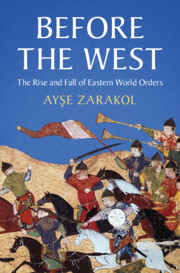Book contents
- Before the West
- LSE International Studies
- Before the West
- Copyright page
- Dedication
- Contents
- Figures and Maps
- Acknowledgements
- Maps
- 1 What Is the East?
- Part I Cihannüma
- 2 Making the East: Chinggisid World Orders
- 3 Dividing the East: Post-Chinggisid World Orders
- 4 Expanding the East: Post-Timurid World Orders
- 5 How the East Made the World: Eurasia and Beyond
- Part II Lessons of History
- Bibliography
- Index
4 - Expanding the East: Post-Timurid World Orders
The Ottomans, the Safavids and the Mughals (Fifteenth–Sixteenth Centuries)
from Part I - Cihannüma
Published online by Cambridge University Press: 24 February 2022
- Before the West
- LSE International Studies
- Before the West
- Copyright page
- Dedication
- Contents
- Figures and Maps
- Acknowledgements
- Maps
- 1 What Is the East?
- Part I Cihannüma
- 2 Making the East: Chinggisid World Orders
- 3 Dividing the East: Post-Chinggisid World Orders
- 4 Expanding the East: Post-Timurid World Orders
- 5 How the East Made the World: Eurasia and Beyond
- Part II Lessons of History
- Bibliography
- Index
Summary
This chapter shows that the sixteenth century was not dominated by European actors but rather by three post-Timurid empires in west Asia, that expanded the reach of the Chinggisid sovereign norm and world ordering into new territories. These empires were the Ottoman, the Mughals and the Safavid, and together they ruled over a third of the world's population and controlled much of the world's resources. They also developed their own version of the Chinggisid sovereignty model, inflected by Timurid influences and varying according to local cultural repertoires. This was the notion of 'millennial sovereignty' as captured by the concept of sahibkıran, essential a ruler marked by conjunction astrology for great distinction. Ottoman, Safavid and Mughal rulers competed with each other (and Charles V) for the title of sahibkıran. Their world order was connected through intellectual network of astrologers and other occult scientists who legitimised universal empire projects. This chapters develops a comparative narrative of these three empires and their rulers' universal empire dreams in the sixteenth century.
Keywords
- Type
- Chapter
- Information
- Before the WestThe Rise and Fall of Eastern World Orders, pp. 124 - 172Publisher: Cambridge University PressPrint publication year: 2022

